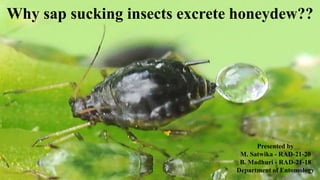
why sap sucking insects excrete honey dew.pptx
- 1. Why sap sucking insects excrete honeydew?? Presented by M. Satwika - RAD-21-20 B. Madhuri - RAD-21-18 Department of Entomology
- 2. In general, digestion and absorption of food takes place in the midgut. In sap sucking insects, the food directly passes from the anterior part of the midgut to the hindgut i.e. morphological adaptation of sucking pests (filter chamber). Hence, less absorption of the food occurs. Sap sucking insects takes food continuously to compensate the more loss of water, sugars and amino-acids. Eg: On susceptible plants, aphids often feed continuously from single sieve elements for extended periods. The evidence comes principally from the “honeydew clock” experiments, where each honeydew droplet is of uniform size at regular intervals of once per 15–40 min. Why??
- 3. When their mouthparts penetrate the phloem, the sugary, high pressure liquid is forced out of the anus of the aphid. Honey dew accumulate in the rectum prior to elimination. The rectal epithelium of aphids is very thin, offering minimal barrier to water and ion movement. As a result, sap sucking insects excretes honeydew (rich in sugars) after passing through filter chamber.
- 4. The excreted liquid, on drying, leaves a white deposit on the plant leaves is called manna. Manna is excreted by coccid Trabutina mnannipara feeding on tamarisk in sinai which contains 99.3 % carbohydrates. The reason for the wasteful method of feeding due to deficiency of organic nitrogenous compounds in plant juice. Therefore, insect takes large quantities of plant juice continuously in order to get sufficient aminoacids and proteins. As a result, it excretes manna with excess carbohydrates. This was not found in the case of Pineapple mealybugs, since large quantities of free amino acids and sugars were found to be present in their honey dew.
- 5. Digestion of the sucrose in sap sucking insects α-glucosidases are the carbohydrases which hydrolyze specific disaccharides and oligosaccharides. Sucrase is an example of α-glucosidases. Sucrase break sucrose in the midgut of aphids. Sucrase generally mediate hydrolysis because water is the typical acceptor for the sugar residues, but sugar at high concentrations can act as a acceptors, resulting in the formation of oligosaccharides. Thus, the aphid sucrase can mediate the formation of trisaccharides and longer chain oligosaccharides which are commonly voided in the honey dew. However, the ingested sucrose is undetectable or accounts for a very small proportion of the honeydew sugars, suggesting that the voided sugars are the product of extensive enzymatic modification in the insect gut.
- 6. Sucrase In general : Sucrose Glucose + Fructose (Disaccharide) Midgut (Monosaccharide) + (Monosaccharide) Sucrase In aphids : Sucrose Trisaccharides + Oligosaccharides (Disaccharide) Midgut (Honey dew) The glucose moiety of much of the ingested sucrose is channelled into oligosaccharide synthesis and voided via the honeydew, while the sucrose derived fructose is assimilated quantitatively from the gut in to the aphid tissues.
- 7. Chemical transformations of sucrose in the gut contribute to aphid osmoregulation The osmotic pressure of phloem sap is 2–4 times greater than that of aphid body fluids. As a result, an aphid would be expected to lose water to the lumen of the alimentary tract and shrivel as it fed. The transformation of ingested disaccharides (sucrose) to oligosaccharides by sucrase or transglucosidase would tend to reduce the osmotic pressure of the gut. This is called transglucosidase activity. By this activity, osmoregulatory collapse is circumvented by downregulation of the osmotic pressure of the gut contents, such that the aphid honeydew and haemolymph are isosmotic.
- 8. Other examples: In Madagascar, some gecko species in the genera Phelusma and Lygodactylus are known to approach flattid plant- hoppers on tree-trunks from below and induce them to excrete honeydew by head nodding behaviour. The plant- hoppers then raises its abdomen and excretes a drop of honeydew almost right onto the snout of the gecko. Trophobiosis
- 9. The genomic sequencing of Drosophila and mosquito for cellulase gene Genetic capacity to produce cellulase enzyme is not universal, among the insects. The genomes of all Drosophila and mosquito species have been sequenced to date lack an identifiable cellulase gene. GHF9 (Glucoside hydrolase family) cellulase gene is found in honey bee genome. Many experiments were conducted by dropping the GHF9 gene in Drosophila and Anopheles. But, honey bee cellulase gene is not conserved in these species, as all of which lack cellulase.
- 10. References: Chapman R. F. 2014. The Insects: structure and function. Cambridge university press. lec-16,463-499. Douglas A. 2003. The Nutritional Physiology of Aphids. Advances in Insect Physiology. 31:73-140. Kunieda. T et al. 2006. Carbohydrate metabolism genes and pathways in insects: Insights from the honey bee genome. Insect molecular biology. 15 (5): 563-76.